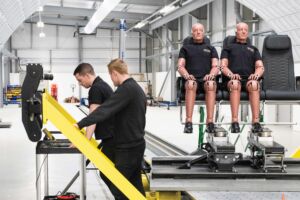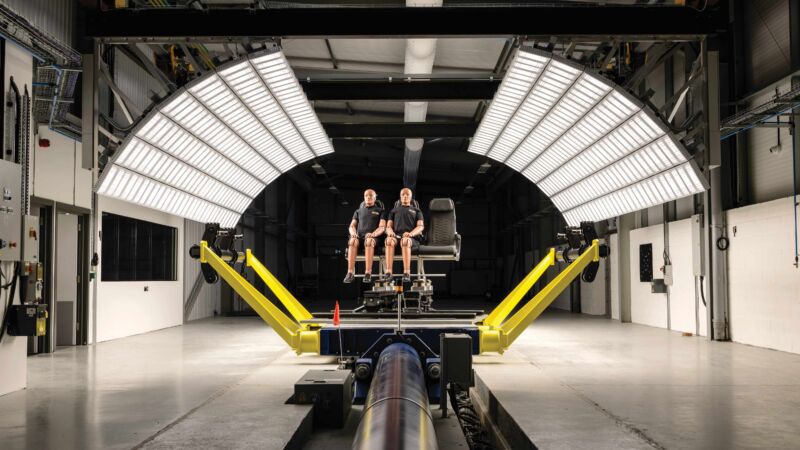Aimée Turner paid a visit to Mirus Aircraft Seating’s Norfolk headquarters to explore how its £4 million investment could give the business the edge in a highly competitive market segment
In launching the UK’s largest commercially available and most technologically advanced crash test facility, Mirus is staking a claim in the lightweight seat manufacturing landscape of the future.
The purpose-built 407sqm M-TEST facility at its Norfolk-headquarters represents a £4 million investment and has been developed to rival the most advanced facilities in Europe.
The showpiece of the centre is a state-of[1]the-art, 30m-long dynamic test sled, a bespoke device used for destructive and non-destructive crash test replication.
Momentous Milestone
Lit by a powerful state-of-the art lighting system, the LED lamps ensure the comfort for the engineering teams and represents a significant reduction in terms of energy consumption.
Ben McGuire, chief executive at Mirus, says the addition of its very own in-house testing facility is a momentous milestone for the company and will serve not only the aircraft interiors community but will also be made available to the automotive, aerospace, motorsport and rail vehicle industries.

Future customers of M-TEST can also be assured of a dedicated and independent team running a facility in a strictly confidential testing environment thanks to a ringfenced IT system that will generate the vital intelligence on their product’s performance.
“With the ability to undertake testing accredited by Lloyd’s Register and in line with ISO 17025 and ACEA regulations,” McGuire says, “M-TEST will enable us to test and certify not only Mirus seating products, but also deliver a solution to the increased demand for sled testing.”
Most importantly however, the new facility will allow Mirus itself to develop new technologies at a much faster pace – enabling greater innovation and speed to market for not only Mirus’ flagship product, the Hawk seat, which now numbers more than 120,000 in service but also its new fixed back economy class Kestrel seat.
Adam Challenor, technical director at Mirus Aircraft Seating, tells Aircraft Cabin Management that building one of the most technologically advanced crash test facilities to meet the requirements of the broader transportation industry was challenging:
Test and develop more quickly
“We’ve had to dig very far down to anchor it so there’s a lot of concrete in there.” Having its own test centre on site will save Mirus a significant amount of time and expense, as it will no longer have to send engineers for overnight stays at alternative UK testing sites – where they are also prevented from taking photography.
“We can run the sled five days a week,” says Challenor. “Normally, we will use it between 40 per cent and 60 per cent of that time, depending on where our programming is so we’ve got at least 50 per cent capacity that we can go on sale elsewhere.
“In terms of what it will allow us to do, it means we can actually test and develop much more quickly because we won’t have to go travelling elsewhere.
“Something that would have taken three days, we can now do in two hours plus we can get all of our engineers here to watch the testing, so our turnaround time will be significantly reduced and our throughput of tests so much higher.

“That means we can do a better job of developing a product; we can be less scared of failure. We can push the boundaries in terms of the design and therefore end up with a better, more lightweight product.”
Challenor says certification requirements for aircraft seating are in a continual state of flux and are becoming ever more stringent, particularly in terms of how impact to the head is managed.
“We’re under continual pressure to reduce development time and a big part of that is testing to optimise the product for weight, for cost and for performance,” he said.
Challenor added that as the requirements for aircraft seats are slowly starting to converge with the requirements for automotive in terms of neck injury, by being able to test more, Mirus will be able to develop the products to catch those stringent requirements.
McGuire, explaining more about the reasoning for the investment, says it is not only to take the young seating business’s products to market much more quickly but also to show its long-term commitment to the aircraft seating segment directed at the OEMs Airbus and Boeing, and all its current and potential airline customers.
“We’re a relatively new company. I wouldn’t call Mirus a start-up any more, as we started in 2015. We were doing quite well and then along came the pandemic.
“Our existing customers stayed loyal, so we didn’t lose business. Additionally, our shareholders were very supportive and continue to be so as they’re investing in us for the future.
Market roaring back post-pandemic
“When we came out of the pandemic, we knew more products were needed to capitalise on a market that is going to come roaring back for sure.
“Our job as a seat manufacturer is to ensure that we keep producing seats that give passengers as much space and comfort as possible so, even in higher density configurations, the passenger will have a reasonable amount of living space. Our new test facility allows us to really push this.”
The business launched its new fixed-back economy class Kestrel seat last summer at Aircraft Interiors Expo.
The lightweight Kestrel weighs in at just 7.5kg (16.5lb) and is destined for operators of short haul and even medium haul routes, enabling airlines – whether ultra-low cost or premium carriers – to achieve maximum economy cabin densification without compromising passenger comfort – even at a 28in (71cm) seat pitch.
From the outset, the design principles of the seat with all its different trim and finish options, as well as additional features such as USB ports, PED holders and literature pocket choices, were led by a zero-compromise mindset in terms of space, privacy and comfort.
Mirus has multiple patents pending on the Kestrel’s design, focused on its maintainability, extended durability testing, low part-count and reduced layering of components.
Another feature is extended warranty, which Mirus reckons will dramatically lower the lifetime cost of ownership and enable airlines to generate a return on investment within a few years.
“We’ve already had feedback that the Kestrel seat is best in class,” says McGuire. “It offers living space at maximum densities because we can make it lighter, we can make it thinner – and that’s all gained by being able to conduct continuous development testing.”


